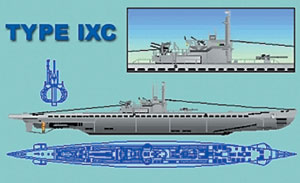What's happening in production
Look what I found at work today: a submarineImagine yourself diligently going about your work, surveying a planned pipeline route in the Gulf of Mexico. Then you see something very strange and ask, "What’s that?" After some investigation, it turns out that you have discovered a long-sought undersea wreckage: the German World War II submarine U-166. BP and Shell announced the discovery in June and reported it to government officials, who confirmed the find and subsequently notified the German government. The discovery was made by the world’s first commercial autonomous underwater vehicle (AUV) operated in deep water.
Named the Hugin-3000, the AUV is contracted to BP and Shell and was developed and operated by C & C Technologies, Inc., which recently earned the Marine Technology Society’s "Corporate Excellence Award" for its pioneering efforts in AUV technology. Although untethered, to be precise, the AUV is not truly autonomous; rather, it is periodically instructed / re-programed by a shipboard operator via acoustic modem. The AUV is about 18 ft long and 3 ft in diameter. It cruises at 4 kt in water depths up to 10,000 ft, and navigates along pre-programed survey lines. An aluminum / oxygen fuel cell enables up to 40 hr of operation. The AUV carries state-of-the-art sensors that include side scan sonar, a multibeam echo sounder and a sub-bottom profiler, which acoustically examines the seafloor for geologic faults or shallow-gas hazards. In addition, a fiber optic gyrocompass, inertial navigation system and Doppler-velocity log help the AUV determine its location. U-166 was a type IX-C German submarine that operated in the Gulf and sank four Allied ships (7,600 t) during its first patrol. The submarine lies near one of its victims, the American passenger freighter S.S. Robert E. Lee, which was sunk by torpedo on July 30, 1942, and whose location was previously known. Twenty-five passengers and crewmembers on the Robert E. Lee died. U-166 was sunk shortly thereafter by the U.S., killing all 52 submariners onboard. Both vessels are resting in nearly 5,000-ft-deep water, about 45 mi from the mouth of the Mississippi River. Escorting the Robert E. Lee was a Navy patrol vessel, PC-566, which dropped depth charges after sighting a periscope. An oil slick appeared after the charges exploded. However, the U.S. Coast Guard is credited with having sunk U-166 two days later with a single depth charge dropped from a plane – the only submarine sunk in the Gulf of Mexico. The sinking of the submarine and its ultimate fate has been debated for decades. Finding U-166 will help settle this chapter of maritime history. The discovery was made while surveying the Okeanos Gas Pipeline. It is part of the joint BP and Shell development projects, Na Kika and Crazy Horse, which lie in ultra-deepwater. The companies notified MMS of the find and elected to re-route the Okeanos pipeline around the site. The companies also voluntarily funded a video investigation of the sunken vessels, using an Oceaneering, Inc. ROV. The video provided detailed images of the wreck, which was needed by archeologists to document the find. BP and Shell are continuing to provide information about the discovery to U.S. and German governments, in an effort to help bring closure to these 60-year-old events. Unstranding gas. Atlantic Methanol Production Company (AMPCO) began shipping methanol from its West African plant in late May. Initial delivery is scheduled for Europe in mid-June. The plant is located on Bioko Island in the Republic of Equatorial Guinea, and will monetize over 100 MMcfgd of what would otherwise be considered stranded (uneconomic to deliver) gas. CMS Energy and Noble Affiliates each own a 45% interest in AMPCO, with the government holding the remaining 10%. In a related development, CMS Oil and Gas Co. successfully completed and tested a whopper of a gas / condensate development well in Alba field, Equatorial Guinea, which more than doubled proven and probable reserves in the field. The Alba 9 well, located north of Bioko Island and 2.4 mi from the nearest producing well, tested at 37.5 MMcfd gas and 2,400 bpd of condensate. The well produced from 120 ft of perforations on a 1-in. choke at 2,473 psi FTP and only 197 psi BHP drawdown. The wellbore encountered 1,000 ft of gross sand thickness and 732 ft of net pay. Estimates are that the well is capable of producing
100 MMcfd and 6,200 bcpd. Proven and probable reserves are now estimated at more than 300 million bbl of
liquid hydrocarbons associated with 4.6 Tcfg. A recently completed development program for Alba field
increased daily production to 16,000 bbl of condensate, 2,400 bbl NGLs and 240 MMcfg. Gas that cannot be
utilized at the new methanol plant will be re-injected into the reservoir.
|
- Applying ultra-deep LWD resistivity technology successfully in a SAGD operation (May 2019)
- Adoption of wireless intelligent completions advances (May 2019)
- Majors double down as takeaway crunch eases (April 2019)
- What’s new in well logging and formation evaluation (April 2019)
- Qualification of a 20,000-psi subsea BOP: A collaborative approach (February 2019)
- ConocoPhillips’ Greg Leveille sees rapid trajectory of technical advancement continuing (February 2019)




